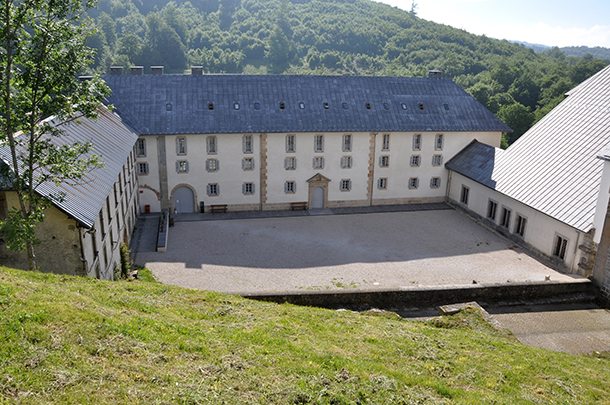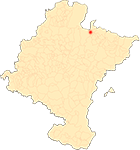Roncesvalles
By Javier Martínez de Aguirre Aldaz
Dependencies of the Collegiate Church
A new hospital complex to the north of the church had been planned since 1792. In 1803, the old hospital was demolished in order to build the priory house. In 1807, the rooms were laid out for entrance to be put into operation. Initially, the eastern nave was built. Later, the wing that was to close off the courtyard was added to the previous Building . In the 21st century, its recovery has been completed in order to maintain its original purpose, adapted to modern times as a hostel.
The current priory house was built under the direction of José Poudez. A few years later, the passageway to the church choir was built on the western gallery of the cloister. In 1819, the priory was extended with a Building attached to its western side. The third building, which today completes the southern façade of the collegiate complex, was erected during the mandate of Prior Polit (1887-1906). The façades of these three buildings, despite belonging to different dates, have achieved a certain uniformity.
Library Services and file house rich collections from the average age to the present day. The Museum houses some beautiful gospel covers (13th century), decorated by embossing with the Maiestas Domini and the Crucifixion. Other outstanding pieces are a small box made around 1300, the delicate image of the Virgin called the Treasure (14th century), the 16th century enamelled altarpiece of the Passion, the splendid processional cross from the same century, a gift from Don Francisco de Navarra, the triptych of the Crucifixion from the 16th century, the Holy Family by Luis de Morales, etc. Among the canvases of interest are the Martyrdom of Saint Lawrence, attributed to Pedro de Orrente and the Judith with the Head of Holofernes from the mid-17th century. Among the sculptures, the reliefs and statues from the Romanesque altarpiece executed between 1614 and 1624 by Gaspar Ramos and Victorian de Echenagusía are worth mentioning.
Dectot, X., "Yacente de Sancho VII el Fuerte", in Bango Torviso, I.G. (dir. cient.), Sancho el Mayor y sus herederos. El linaje que europeizó los reinos hispanos, Pamplona, 2006, pp. 371-373.
Fernández-Ladreda, C., Imaginería medieval mariana en Navarra, Pamplona, 1989.
Fernández-Ladreda, C. (Dir.), Martínez Álava, C., Martínez de Aguirre, J. and Lacarra Ducay, M.C., El arte gótico en Navarra, Pamplona, 2015.
Fuentes y Ponte, J., report histórica y descriptiva del santuario de Nuestra Señora de Roncesvalles, Lérida, 1880.
García Gainza, M.C., Orbe Sivatte, M. and Domeño Martínez de Morentin, A., Catalog Monumental de Navarra IV**. Merindad de Sangüesa, Pamplona, 1992.
Ibarra, J., History of Roncesvalles. Art. History. Legend, Pamplona, 1936.
Lambert, E. Roncevaux", Bulletin Hispanique, XXXVII (1935), pp. 417-436.
Martínez de Aguirre, J. (coord.), Enciclopedia del Románico en Navarra, Aguilar de Campoo, 2008, vol. III, pp. 1216-1224.
Martínez de Aguirre, J., Gil Cornet, L. and Orbe Sivatte, M., Roncesvalles. Hospital and sanctuary on the Camino de Santiago, Pamplona, 2012.
Miranda García, F. and Ramírez Vaquero, E., Roncesvalles, Pamplona, 1999.
Peris, A., "El Ritmo de Roncesvalles: estudio y edición", Cuadernos de Filología Clásica. Latin Studies, 11 (1996), pp. 171-209.
Pons Sorolla, F., "project de obras de restauración en la capilla del Sancti Spiritus de la Real Colegiata de Roncesvalles (Navarra)", Príncipe de Viana, XXXIX (1978), pp. 59-77.
Soria i Puig, A., The Road to Santiago. II. Stations and signs, Madrid, 1992.
Torres Balbás, L. La iglesia de la hospedería de Roncesvalles", Príncipe de Viana, VI (1945), pp. 371-403.
Thuile, J., L'Orfèvrerie en Languedoc du XIIe au XVIIIe siècle. Généralité de Montpellier, Montpellier, 1966.












